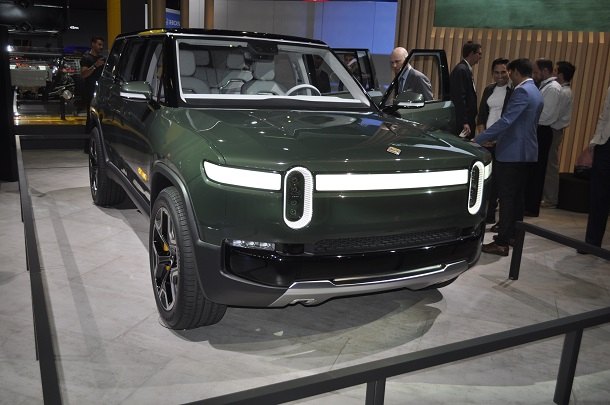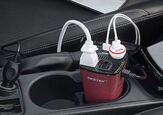One-two Punch: Rivian Debuts Seven-seat Electric SUV, Promises 410 Miles of Range

Having just unveiled a rather impressive all-electric pickup for the LA Auto Show, Michigan-based automotive startup Rivian is following up with another model. Rivian’s second vehicle will be a seven-passenger SUV, called the R1S, that uses the same platform as the R1T e-pickup.
That results in the pair playing host to nearly identical specs. This isn’t a problem, as the automaker vows to provide between 300 and 562 kW (402 and 753 hp) in combined output. Range is similarly good. The company is also promising figures that would make most other electric vehicles of this size blush, especially if you opt for the bigger battery.
As with the pickup, the R1S can be had with a 105 kWh pack capable of about 240 miles of range, a 135 kWh version good for around 310 miles, and a 180 kWh unit rocking 410 miles. Those range estimates are slightly better than those cited for the pickup; they’ll surely fluctuate a bit when traveling with a full load in either vehicle.
Visually, the R1S resembles an EV concept from Land Rover with a dash of Ford Flex for taste. Interesting, considering it looks identical to the pickup from the front. But we didn’t really notice the R1T having so much in common with other models when we first laid eyes on it. Meanwhile, the R1S instantly makes us think we’ve seen it somewhere before.
Rivian’s SUV should be capable of reaching 60 mph in 4.9 seconds, according to the manufacturer. Higher-spec models should be able to shave at least a full second off that time. The R1S will have the same quad-motor setup as the R1T. Working together, the motors will yield around 400 horses on the base model, 750 hp when attached to the 135 kWh battery, and 700 hp with the 180 kWh unit.
The R1S also has the same frunk as the pickup, providing an additional 11.7 cubic feet of storage space where you’d normally find an engine. It also has a bin at the rear intended for a spare tire, but you can chuck whatever you want into it if you’re feeling bulletproof. The R1T’s “gear tunnel” does not carry over onto the SUV, however.
Less utilitarian and work-focused than the company’s pickup (towing capacity is down from 11,000 pounds to 7,700), Rivian claims the R1S will still be able to tackle bad roads and handle its business. There remains a clear emphasis on luxury, though. The SUV’s interior has a massive 15.6-inch touchscreen that’s impossible to miss. A second, 12.3-inch screen serves to provide meaningful data to the driver while a third 6.8-inch screen has been installed in the center console for rear passengers. According to the manufacturer, the model will come pre-equipped with sensors capable of some self-driving assistance at launch and upgradable over the air, like on a Tesla.
Scheduled for assembly in 2020 and on display at the LA Auto Show now, the R1S will be slightly more expensive than R1T pickup truck when it goes on sale. The base model starts at $72,500 (before the EV tax credit). If you’re interested, preorders begin this week via a refundable $1,000 deposit. Rivian has said both the SUV and pickup are both “extremely close” to what it plans to put into production.
[Images: Rivian, © 2018 Tim Healey/TTAC]

Consumer advocate tracking industry trends and regulations. Before joining TTAC, Matt spent a decade working for marketing and research firms based in NYC. Clients included several of the world’s largest automakers, global tire brands, and aftermarket part suppliers. Dissatisfied, he pivoted to writing about cars. Since then, he has become an ardent supporter of the right-to-repair movement, been interviewed about the automotive sector by national broadcasts, participated in a few amateur rallying events, and driven more rental cars than anyone ever should. Handy with a wrench, Matt grew up surrounded by Detroit auto workers and learned to drive by twelve. A contrarian, Matt claims to prefer understeer and motorcycles.
More by Matt Posky
Latest Car Reviews
Read moreLatest Product Reviews
Read moreRecent Comments
- Jalop1991 MC's silence in this thread is absolutely deafening.
- MaintenanceCosts Spent some time last summer with a slightly older Expedition Max with about 100k miles on the clock, borrowed from a friend for a Colorado mountain trip.It worked pretty well on the trip we used it for. The EcoBoost in this fairly high state of tune has a freight train feeling and just keeps pulling even way up at 12k ft. There is unending space inside; at one point we had six adults, two children, and several people's worth of luggage inside, with room left over. It was comfortable to ride in and well-equipped.But it is huge. My wife refused to drive it because she couldn't get comfortable with the size. I used to be a professional bus driver and it reminded me quite a bit of driving a bus. It was longer than quite a few parking spots. Fortunately, the trip didn't involve anything more urban than Denver suburbs, so the size didn't cause any real problems, but it reminded me that I don't really want such a behemoth as a daily driver.
- Jalop1991 It seems to me this opens GM to start substituting parts and making changes without telling anyone, AND without breaking any agreements with Allison. Or does no one remember Ignitionswitchgate?At the core of the problem is a part in the vehicle's ignition switch that is 1.6 millimeters less "springy" than it should be. Because this part produces weaker tension, ignition keys in the cars may turn off the engine if shaken just the right way...2001: GM detects the defect during pre-production testing of the Saturn Ion.2003: A service technician closes an inquiry into a stalling Saturn Ion after changing the key ring and noticing the problem was fixed.2004: GM recognizes the defect again as the Chevrolet Cobalt replaces the Cavalier.fast forward through the denials, driver deaths, and government bailouts2012: GM identifies four crashes and four corresponding fatalities (all involving 2004 Saturn Ions) along with six other injuries from four other crashes attributable to the defect.Sept. 4, 2012: GM reports August 2012 sales were up 10 percent from the previous year, with Chevrolet passenger car sales up 25 percent.June 2013: A deposition by a Cobalt program engineer says the company made a "business decision not to fix this problem," raising questions of whether GM consciously decided to launch the Cobalt despite knowing of a defect.Dec. 9, 2013: Treasury Secretary Jacob Lew announces the government had sold the last of what was previously a 60 percent stake in GM, ending the bailout. The bailout had cost taxpayers $10 billion on a $49.5 billion investment.End of 2013: GM determines that the faulty ignition switch is to blame for at least 31 crashes and 13 deaths.It took over 10 years for GM to admit fault.And all because an engineer decided to trim a pin by tenths of a millimeter, without testing and without getting anyone else's approval.Fast forward to 2026, and the Allison name is no longer affiliated with the transmissions. You do the math.
- Normie I'd hate to have to actually use that awkwardly mounted spare tire in a roadside fix scenario. Bumper jack? Tote around a 40 lb. floor jack? That's a high ridin' buggy!
- TMA1 That interior is exactly what you'd expect out of a Sweden/China collaboration: minimilist, but also extremely cheap and flimsy. Congrats to them on making the Dodge Charger look like a good idea.





































Comments
Join the conversation
After 10 years when this $100K truck is totaled because it needs a new battery pack, put a Hellcat crate engine turning a generator in it. It should weigh the same as the 180kw battery pack. That's a far better rich man's toy.
Really nice work. The thing has presence and class, like a Range Rover. Individual motors on each wheel. Useful range. No tailpipe. And it's silly-quick to boot. If I were in the market for a six-figure SUV, this would be it: everything else seems obsolete and backward by comparison. Dealer network, tho???